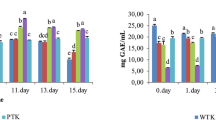Abstract
Indian black tea; CTC leaf and dust, produced by Tata Tea Limited, Kolkata, (India) was studiedin vitro as potential scavenger of oxygen free radicals. Super oxide anions were generated in a system containing xanthine—xanthine oxidase (enzymic system) and by NADH- phenozine methosulphate (non enzymic system). Anions were assayed in terms of uric acid formation and reduction of nitroblue tetrazolium salt, which were shown to be suppressed by tea extracts. Extracts from both leaf and dust also inhibted the formation of hydroxyl radicalsin vitro in the enzymic system comprising hypoxanthine—Cu+2—sodium ascorbate and xanthine oxidase and in non enzymic system of deoxyribose—Cu+2—sodium ascorbate and H2O2 as well as the Cu+2 induced lipid peroxidation in human low density lipoprotein. Feeding with black tea in normal rats for sixty days increased their antioxidant activity and their liver microsomes were shown to be protected against peroxidation of lipids as stimulated by metal ions with enzymic or non enzymic reactants. Furthermore feeding with tea extracts in normal as well as triton WR—1339 induced hyperlipidemic rats caused decrease in their plasma levels of total cholesterol, phospholipids and triglycerides. The antioxidant and lipid lowering activities of both extracts from CTC leaf and dust tea was comparable and may be due to the presence of natural products like catechin and others.
Similar content being viewed by others
References
Grieve, M. (1992). A modem Herbals. Tiger Books International, London. (U.K.)
Lewis, W.H. and Elvin-Lewis, M.P.F (1977) Medical Botany; Plants affecting man’s Health, Inter Science publications, New York, NY,USA.
Wickremasinghe, R.L (1993). Biological activity of tea The Planter 69, 176–179.
Hollman, P.C., Fesken, E and Katan M.B. (1999) Tea flavenols in cardiovascular disease and cancer epidemiology. Proc Exp Biol Med, 220, 198–202.
Yang, C.S. and wang, Z.Y. (1993) Tea and cancer: a review, J.Natt Cancer Inst, 58, 1038–1049.
Tejburg, L.B.M., Mattem, T, Folts, J.D., Weisgerber, U.M. and Katan, M.B. (1997) Tea flavenoids and cardio vascular diseases: a review, 37, 771–785.
Dreosti, I.E. (2000) Antioxidant poly phenols in tea cocoa and wine. Nutition 16, 692–694.
Weisburger, J.H. (1999) Tea and health; the under using mechanisms. Proc. Soc Exp Biol Med. 220, 271–273.
Green, M.S. and Jucha, E. (1986) Association of serum lipids with with coffee, tea and egg consumption in free living subjects. J Epidemiol community Health, 40, 324–329.
Stensvold, I., Tverdal, A. Solvoll, K. and Foss, O.P. (1992). Tea consumption Relationship to cholesterol blood pressure, and coronary and total mortality. Prev.Med. 21, 546–553.
Steinberg, D, Parthasarathy, S, Carew, T.E, Khoo, J. and Witztum, J.L (1989) beyond cholesterol.Modifications of lowersity lipoprotein that increase its atherogenesity. New.Engl.J.Med, 320, 915–924.
Havel, R.J., Eder, H.A., and Bingdon, J.A. (1955). The distribution and chemical composition of ultra centrifugically separated lipoproteins in human serum. J. Clin. Invest. 34, 1345–1353.
Bindoli, A., Valente, M. and Cavallin, L. (1985) Inhibition of xanthine dehydrogenase activity. Phamacol. Res. commun. 17, 831–839.
Mcord, J.M, Fridvich, I., (1969) Superoxide desmutase an enzyme an enzyme function for erythrocuprin (Hemocuprin) J. Biol. Chem. 244; 6049–6055.
Richmand, R., Halliwell, B., Chauhan, J., Darbre, A. (1981) Superoxide dependant formation of hydroxyl radicals: detection of hydroxyl radicals by hydroxylation of aromatic compounds. Anal. Biochem, 118, 328–335.
Halliwell, B. Gutteridge, J.M.C and Arouma, O. (1987) the deoxyribose method: A simple test tube assay for determination of rate consultant for reaction of OH radicals. Annal. Biochem. 165, 215–219.
Okhawa, H., Ohishi, N (1978). Reaction of linoleic acid hydroperoxide with thiobarbituric acid. J. Lipid Res, 19. 1053–1057.
Mair, R.D., Hall, R.T. (1957). In organic peroxides, Swem, D., Vol. II eds wiley. Interscience New York 535.
Devasagayam, T.P.A., Tarachand, U (1987). Decreased lipid peroxidation in the rat kidney during gestation. Biochem. Biophysics. Res. Commun; 145; 134–138.
Deeg, R S Ziegenhom J (1983) Kinetic enzymetic method for automated determination of total cholesterol in serum clin chem., 19, 476–480.
Zilversmit, D B Davis, A K., Memphis B S and Tenn (1950) Micro determination of plasma phospholipids by Tinchloroacetic acid precipitation. J. Lab. Clin. Med. 35, 155–160.
Buccolo G and David H (1973) Quantitative determination of serum triglyceride by the use of enzymes Clin. Chem., 19, 476–80.
Ames, B.N. and Balch, P.A. (1983) Dietary carcinogens and anticarcinogens. Science 22, 1256–1263.
Lunder T.L., Huhang, M.T., Ho, C.T., Lee, C.Y. (1992) Phenolic compounds in food and their effects on health, American Chemical Society, Washington USA. 114–120.
Pratt, D.E. (1992) Natural antioxidant from plant materials in phenolic compounds in food and their effects on health. American Chemical Society, Washington USA. 114–120.
Serafini, M. Ghiselli, A and Luzzi, A.f. (1996). In vivo antioxidant effect of green tea and black tea and black tea in man. Eur. J. Clin. Nutr. 50, 28–32.
Leenen, R., Roodenburg, A.J.C., Tijburg, L.B.M. and wiseman, S.A. (1998) A single dose of tea with or without milk increases plasma antioxidant activity in humans. J. Clin nutr 54. 87–92.
Shurr, P.E., Schultz, J.R. and Parkinson, T.M. (1972) Triton induced hyperlipidemia in rats as an animal model for screening of hypolipidaemic drugs. Lipids 7, 68–74.
Chander, Ramesh, Khanna A.K., Mathur, S.K., Kar, A. and Rastogi, A.K. (2002). Antidyslipemic and antioxidant activities of SBC: Aherbal preparation. Ethanobotany 14, 123–128.
Matsumoto, N. Okushio, K and Hara, Y (1998). Effect of black tea polyphenols on plasma lipids in cholesterol fed rats. J. Nut. Science and vitamilogy 44, 337–342.
Tebib K., Besancon, Pand Rovanet, J.M (1994). Dietary grape seed tannins affect lipoproteins, lipoprotein lipases and tissue lipids in rats fed hypercholesterolemic diet. J. Nutr, 124, 2451–2457.
Vos De A and Schrinjvera De, R (2003), Lipid metabolism, intestinal fermentation and mineral absorption in rats. Nutr Research. 23, 527–537.
Hara, H., Haga, S., Kasai, T., and Kiriyania, S., (1998) Fermentation product of sugar beet fibres by cecal bacteria lower plasma cholesterol concentration in rats. J. Nutr 128, 688–693.
Author information
Authors and Affiliations
Corresponding author
Rights and permissions
About this article
Cite this article
Chander, R., Khanna, A.K., Raj, K. et al. Antioxidant and lipid lowering activities of Indian black tea. Indian J Clin Biochem 20, 153–159 (2005). https://doi.org/10.1007/BF02893063
Issue Date:
DOI: https://doi.org/10.1007/BF02893063




